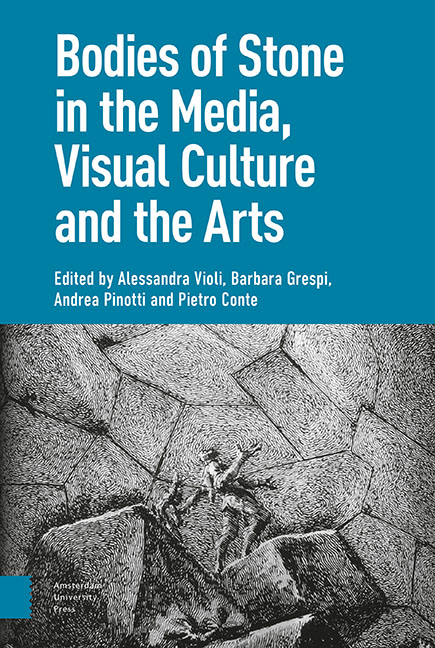Book contents
- Frontmatter
- Contents
- Introduction: Learning from Stone
- I Statue: The Imaginary of Uncertain Petrification
- 1 Theatre and Memory: The Body-as-Statue in Early Modern Culture
- 2 Translated Bodies: A ‘Cartographic’ Approach
- 3 Pantomime in Stone: Performance of the Pose and Animal Camouflage
- 4 Animated Statues and Petrified Bodies: A Journey Inside Fantasy Cinema
- 5 The Ephemeral Cathedral: Bodies of Stone and Configurations of Film
- II Matter: Size, Hardness, Duration
- 1 Bodies That Matter: Miniaturisation and the Origin(s) of ‘Art’
- 2 Brancusi’s ‘Sculpture for the Blind’
- 3 Cinema, Phenomenology and Hyperrealism
- 4 Ephemeral Bodies: The ‘Candles’ of Urs Fischer
- 5 The Celluloid and the Death Mask: Bazin’s and Eisenstein’s Image Anthropology
- III Corpse: Fossils, Auto-Icons, Revenants
- 1 Funeral Eulogy: Post-Mortem Figures and Redeemed Bodies, in Images
- 2 On Jack Torrance As a Fossil Form
- 3 Technical Images and the Transformation of Matter in Eighteenth-Century Tuscany
- 4 Glass, Mixed Media, Stone: The Bodily Stuffs of Suspended Animation
- 5 Bodies’ Strange Stories: Les Revenants and The Leftovers
- IV Monument: Embodying and Grafting
- 1 The Impassibly Fleshly, the Statue of the Impossible
- 2 Frozen into Allegory: Cleopatra’s Cultural Survival
- 3 The Orphan Image
- 4 The Well-Tempered Memorial: Abstraction, Anthropomorphism, Embodiment
- 5 Monuments of the Heart: Living Tombs and Organic Memories in Contemporary Culture
- Index
3 - The Orphan Image
Published online by Cambridge University Press: 20 November 2020
- Frontmatter
- Contents
- Introduction: Learning from Stone
- I Statue: The Imaginary of Uncertain Petrification
- 1 Theatre and Memory: The Body-as-Statue in Early Modern Culture
- 2 Translated Bodies: A ‘Cartographic’ Approach
- 3 Pantomime in Stone: Performance of the Pose and Animal Camouflage
- 4 Animated Statues and Petrified Bodies: A Journey Inside Fantasy Cinema
- 5 The Ephemeral Cathedral: Bodies of Stone and Configurations of Film
- II Matter: Size, Hardness, Duration
- 1 Bodies That Matter: Miniaturisation and the Origin(s) of ‘Art’
- 2 Brancusi’s ‘Sculpture for the Blind’
- 3 Cinema, Phenomenology and Hyperrealism
- 4 Ephemeral Bodies: The ‘Candles’ of Urs Fischer
- 5 The Celluloid and the Death Mask: Bazin’s and Eisenstein’s Image Anthropology
- III Corpse: Fossils, Auto-Icons, Revenants
- 1 Funeral Eulogy: Post-Mortem Figures and Redeemed Bodies, in Images
- 2 On Jack Torrance As a Fossil Form
- 3 Technical Images and the Transformation of Matter in Eighteenth-Century Tuscany
- 4 Glass, Mixed Media, Stone: The Bodily Stuffs of Suspended Animation
- 5 Bodies’ Strange Stories: Les Revenants and The Leftovers
- IV Monument: Embodying and Grafting
- 1 The Impassibly Fleshly, the Statue of the Impossible
- 2 Frozen into Allegory: Cleopatra’s Cultural Survival
- 3 The Orphan Image
- 4 The Well-Tempered Memorial: Abstraction, Anthropomorphism, Embodiment
- 5 Monuments of the Heart: Living Tombs and Organic Memories in Contemporary Culture
- Index
Summary
Abstract
This contribution offers an example of a monumental narration arising out of images of death. This is the case of Amos Humiston, a sergeant at the front in the American Civil War who, as he lay dying, chose to look at the photograph of his three children. The monumentalising cadaver's pose transforms him into an exemplary individual whose story deserves to be recounted and to whom a name needs to be given. A bronze plaque including the photograph of the children was built in his memory; the plaque is one of the most common forms of monument undergoing reconsideration in contemporary art. What it mineralises here is not so much the corpse of the soldier but his story as a whole.
Keywords: Childhood portrait photography; unknown soldier; survival of images; monumentalisation
Milite ignoto.To the unknown soldier. On 4 November 1920, to honor all the fallen soldiers of the Great War on the anniversary of the armistice, an unusual event of long-lasting significance took place in Rome, to be remembered in the history of the country as the day of the Unknown Soldier. At the Vittoriano—that marble giant, so brazenly white, placed among the buildings of Medieval Rome—the nameless body of one of the many unknown soldiers fallen at war was buried in a small temple next to the equestrian statue of the ‘little king’ of Piedmont and the first of united Italy, Vittorio Emanuele II, and under the statue of the Goddess Roma. The unknown body of a man was entombed in the anonymous marble body of the city. The idea had come from Giulio Douhet, a colonel on leave and a promoter of the National Union of Officers and Soldiers. In August 1920, in the pages of Il Dovere—a weekly publication he founded and directed—he proposed that the sacrifices and the heroism of the national community during the Great War should be remembered through the body of a soldier without a name, who would thus ideally stand for all the husbands, sons and fathers who had gone missing, their remains never found. But whose remains were to be chosen? Which body, among so many unknown corpses, could be the right one to become everyone's body?
- Type
- Chapter
- Information
- Bodies of Stone in the Media, Visual Culture and the Arts , pp. 317 - 324Publisher: Amsterdam University PressPrint publication year: 2020



